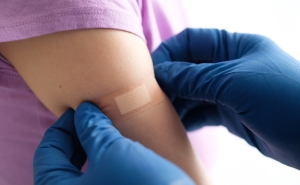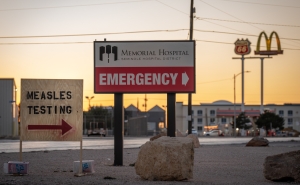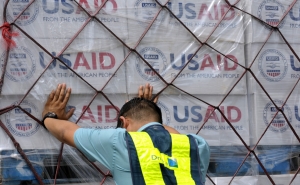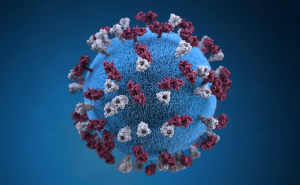Rethinking Herd Immunity and the Covid-19 Response End Game

In the months following the emergence of SARS-CoV-2, “herd immunity” was frequently cited as the long-term destination of the COVID-19 pandemic. As vaccination has rolled out, variants have emerged, and as cases surge once again, we are learning more about the nuances of SARS-CoV-2 infection and what short- and long-term immunity to this virus may look like. With this changing perspective, how should we be thinking about herd immunity?
In this Q&A, epidemiologists Gypsyamber D’Souza and David Dowdy explain that herd immunity is still possible for COVID-19, but that we might need to think a bit differently about what that means in this phase of the pandemic.
What do epidemiologists mean when they talk about “herd immunity”?
When most of a population is immune to an infectious disease, this provides indirect protection—also called population immunity, herd immunity, or herd protection—to those who are not immune to the disease.
For example, currently over 90% of all children in the U.S. are vaccinated against measles, mumps, and rubella by their second birthday. This level of vaccination provides protection to the population as a whole—even to those who aren’t vaccinated—by decreasing viral circulation and the chance someone who is unvaccinated will encounter the virus. If a person with measles were to come to the U.S., for example, nine out every 10 people that person could infect would be immune, making it very hard for measles to spread in the population. As a result, even though we still see localized outbreaks of measles in the U.S., those outbreaks generally die down without starting a nationwide epidemic.
The same idea works for any infectious agent, including coronavirus. The hope is that the population can develop a high enough level of immunity to keep spread low.
The more contagious an infection is, the higher the proportion of the population that needs immunity before infection rates start to decline. But this percentage isn’t a “magic threshold” that we need to cross—and it’s not just dependent on the level of population immunity. Both viral evolution and changes in how people interact with each other can bring this number up or down as well. But even below any “herd immunity threshold,” immunity in the population (for example, from vaccination) can still have a positive effect by reducing the total number of infections that happen.
Is herd immunity still an achievable goal for COVID-19?
Yes—but “herd immunity to COVID-19” does not mean that we will soon achieve a level of immunity in the population, like what we see with measles, and coronavirus will be “over.” Returning to life as it was before the pandemic, without seeing large coronavirus outbreaks, is unlikely to happen for several years, for a few reasons.
First, it has proven much harder to get people vaccinated against COVID-19 than against measles. As of September 2021, just over half of the US population was fully vaccinated against COVID-19—even though we know that the FDA-approved vaccines are extremely safe and have remained highly effective, even against new variants like the delta variant.
Second, young children are still not eligible for the vaccine, and new children (who are susceptible to COVID-19) are born every day. So, until we get vaccines that are approved for use in all ages, there is likely to be ongoing transmission of the coronavirus in kids, who will in turn be able to infect adults, especially unvaccinated ones.
Third, while our vaccines against COVID-19 are very effective and dramatically reduce the risk of infection, they do not reduce that risk to zero. People who have gotten vaccinated can still become infected (so-called breakthrough infections), and some people who have had COVID-19 can get it again. This means that we would need an even higher level of vaccination against COVID-19 to achieve herd immunity.
For all these reasons, it will be very challenging to get to the level of population immunity against COVID-19 that we have seen with measles in the U.S. We should therefore expect to see some level of ongoing coronavirus transmission in our population for many years (if not forever). But as we build immunity to SARS-CoV-2, the risk of severe illness will decrease, and future waves of infection won’t be as disruptive.
So, how should we be thinking about herd immunity to COVID-19?
Because we can’t eliminate SARS-CoV-2, there is a real risk that it will continue to circulate until the vast majority of the population will be exposed—but vaccinated individuals are less likely to be infected when exposed, and they are largely protected from the worst outcomes of infection. In the U.S., someone who is vaccinated has less than 1/10th the risk of getting seriously ill as someone who is not.
This level of protection against severe disease makes it possible that—even if we can’t eliminate transmission of the coronavirus soon—we can get to a level of population immunity where COVID’s effects can be manageable. For example, by achieving high levels of vaccination before the summer of 2021, countries like Germany, Spain, and Canada have kept their COVID-related death rates much lower than what we have seen in the U.S.—even though they have seen surges in cases like those seen in the U.S. COVID mortality rates in these countries are similar to the death rates from suicide or motor vehicle crashes in the U.S. Each of these deaths is a tragedy, but this comparison suggests that, if we can increase vaccination levels, we can eventually get COVID-19 to a level where its effects are like those of other major public health concerns in this country.
Does that mean we can stop wearing masks indoors or avoiding large gatherings?
Unfortunately, not yet. Eventually, we can expect that levels of serious COVID-19 illness will drop to a point where we will be able to ease most restrictions. But as of September 2021, levels of coronavirus transmission—as measured by the risk of serious disease in an unvaccinated person—are higher in some places than they have ever been. When virus transmission levels are high, it makes sense to take measures that will protect both ourselves and those we love, including getting vaccinated, wearing masks indoors, getting tested any time we are exposed to someone with COVID-19, and avoiding large indoor gatherings.
What is the final destination for herd immunity and COVID-19?
The number of people who are immune to the coronavirus is increasing every day. This includes people getting vaccinated and, unfortunately, a lot of people getting COVID-19. At some point—hopefully soon —enough people in our population will have SARS-CoV-2 immunity. With higher immunity levels, and continuing some of the behavioral changes that reduce transmission (like wearing masks), levels of infection will fall again.
Deaths from COVID-19 in the U.S. peaked in January 2021, near the beginning of the vaccine rollout, with more than 3,500 deaths per day. During the September 2021 surge, deaths are approaching 2,000 per day. If we can build up enough immunity in our population, we can keep death rates lower than the ~175 deaths per day we were seeing before this surge. At that point, we can gradually move toward a post-pandemic “new normal” where we still take certain precautions, especially during local outbreaks, but where the pandemic doesn’t impact our lives to the extent it does now.
We are unlikely to eradicate COVID-19 or even to get it to the level of something like measles in the U.S. But we can build up enough immunity in our population to make it a disease that we as a society can live with. We can arrive at this destination soon, if we get enough people vaccinated—and it’s a destination worth working toward.
Gypsyamber D’Souza, PhD ’07, MPH, MS, is a professor and David Dowdy, MD, PhD ’08, ScM ’02, an associate professor in Epidemiology at the Bloomberg School.
NOTE: An earlier version of this article was published on April 16 but was archived on September 13 in light of new information.





